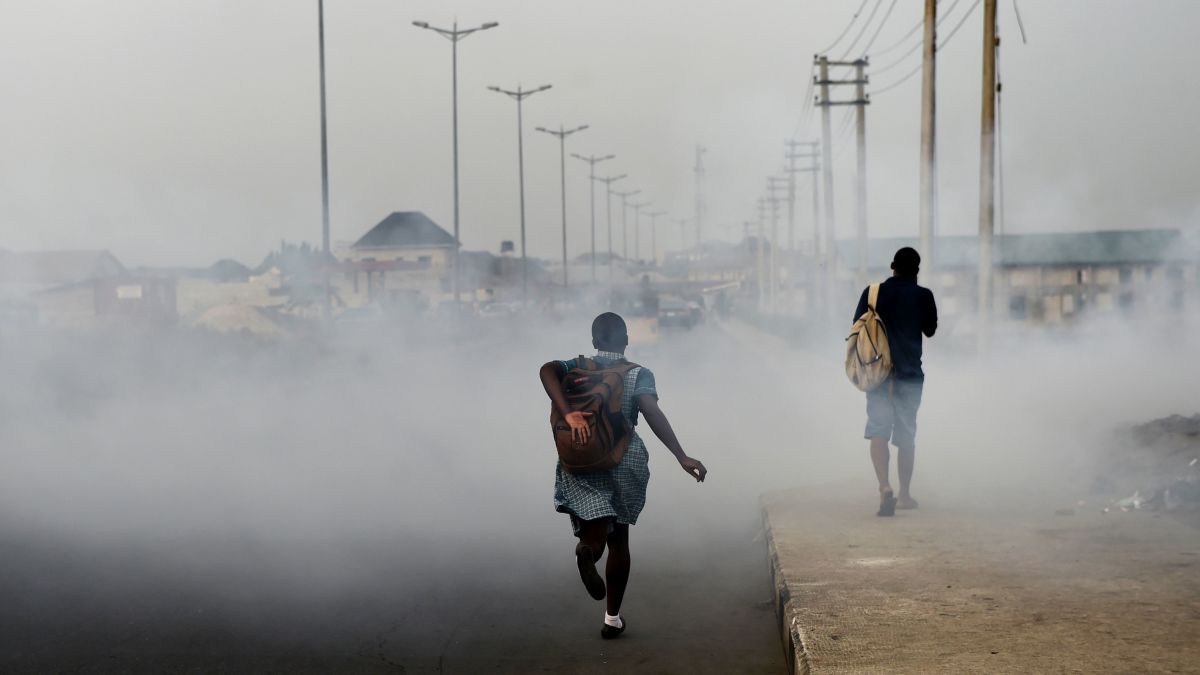October 16, 2025: Kinshasa among top 10 most polluted cities in the world – IQAir

Air Quality Report: Kinshasa, Democratic Republic of the Congo
Date of Report: October 16, 2025
This report details the state of air quality in Kinshasa, Democratic Republic of the Congo, and analyzes its implications for the United Nations Sustainable Development Goals (SDGs). The findings indicate a severe public health crisis that directly contravenes several key SDGs.
Executive Summary: Critical Air Pollution Levels
On October 16, 2025, air quality in Kinshasa was classified as “unhealthy,” with an Air Quality Index (AQI) reaching 201. This level of pollution poses significant health risks to the entire population, undermining progress toward SDG 3 (Good Health and Well-being). The 2024 annual average PM2.5 concentration was 58.2 µg/m³, a figure 11.6 times higher than the World Health Organization’s guideline, highlighting a chronic environmental challenge that impedes the creation of safe and healthy urban environments as envisioned in SDG 11 (Sustainable Cities and Communities).
Analysis of Causal Factors and SDG Misalignment
The persistent poor air quality in Kinshasa is a result of multiple systemic issues. These factors not only degrade the environment but also represent significant barriers to achieving several Sustainable Development Goals.
Primary Pollution Sources
- Dependence on Biomass Fuels: Over 90% of households rely on wood and charcoal for cooking. This practice is a primary driver of indoor and ambient air pollution, directly conflicting with targets for SDG 7 (Affordable and Clean Energy).
- Industrial and Vehicular Emissions: Unregulated emissions from industrial activities and transportation contribute significantly to urban pollution, hindering the development of sustainable infrastructure and production patterns required by SDG 11 and SDG 12 (Responsible Consumption and Production).
- Institutional and Governance Failures: The limited enforcement of environmental laws and ineffective waste management systems point to a critical need for strengthening institutions, a core objective of SDG 16 (Peace, Justice and Strong Institutions).
- Transboundary Pollution: The impact of cross-border pollution from activities such as mining necessitates international cooperation, highlighting the importance of SDG 17 (Partnerships for the Goals).
Forecast and Strategic Recommendations for SDG Achievement
While meteorological conditions are forecasted to provide temporary relief, a sustainable, long-term improvement in air quality is contingent upon structural interventions aligned with the SDG framework.
Recommendations for Action
- Promote Clean Energy Transition: Accelerate the adoption of cleaner cooking fuels and technologies to directly address a primary pollution source and advance SDG 7, while simultaneously improving public health outcomes under SDG 3.
- Strengthen Environmental Governance: Enhance the enforcement of emission regulations for industries and vehicles and establish robust waste management systems. These actions are critical for building effective institutions as outlined in SDG 16 and creating sustainable cities under SDG 11.
- Invest in Monitoring and Data: Expand environmental monitoring programs to gather reliable data. This data is essential for informing evidence-based policies that protect public health and promote sustainable urban development, supporting the objectives of both SDG 3 and SDG 11.
Analysis of SDGs, Targets, and Indicators
1. Which SDGs are addressed or connected to the issues highlighted in the article?
-
SDG 3: Good Health and Well-being
The article directly connects poor air quality in Kinshasa to public health. It describes the air as “unhealthy for the general population,” where “everyone may begin to experience health effects.” It also highlights the risks for vulnerable groups like children and the elderly and mentions the detection of toxic pollutants such as arsenic and lead in the population, all of which are central to ensuring healthy lives.
-
SDG 7: Affordable and Clean Energy
The article identifies a primary cause of air pollution as the “widespread use of biomass fuels, including wood and charcoal, for household cooking, accounting for over 90% of households.” The call for “cleaner cooking fuel adoption” as a long-term solution directly addresses the goal of transitioning to clean and sustainable energy sources.
-
SDG 11: Sustainable Cities and Communities
The focus of the article is on the urban environment of Kinshasa. It discusses issues central to sustainable cities, including ambient air pollution from industrial and vehicular emissions, “ineffective waste management systems,” and the need for “enhanced environmental monitoring programs” and “stricter enforcement of emission regulations” to make the city safer and more sustainable.
2. What specific targets under those SDGs can be identified based on the article’s content?
-
Target 3.9: By 2030, substantially reduce the number of deaths and illnesses from hazardous chemicals and air, water and soil pollution and contamination.
The article’s emphasis on “unhealthy” air quality (AQI of 201), the average PM2.5 concentration being 11.6 times the WHO guideline, and the presence of pollutants like arsenic and lead directly relate to the health risks from air pollution that this target aims to reduce.
-
Target 7.1: By 2030, ensure universal access to affordable, reliable and modern energy services.
The article indicates a significant gap in achieving this target by stating that over 90% of households in Kinshasa rely on polluting biomass fuels (wood and charcoal) for cooking, which is the opposite of using modern and clean energy.
-
Target 11.6: By 2030, reduce the adverse per capita environmental impact of cities, including by paying special attention to air quality and municipal and other waste management.
This target is directly addressed through the article’s detailed reporting on Kinshasa’s severe air pollution, with specific data on PM2.5 levels. The mention of “industrial and vehicular emissions” and “ineffective waste management systems” as contributing factors further aligns the article’s content with this target.
3. Are there any indicators mentioned or implied in the article that can be used to measure progress towards the identified targets?
-
Indicator 11.6.2: Annual mean levels of fine particulate matter (e.g. PM2.5 and PM10) in cities (population-weighted).
The article provides a precise value for this indicator: “the average PM2.5 concentration in 2024 for Kinshasa was 58.2 µg/m³.” It also mentions the daily Air Quality Index (AQI) of 201, which is derived from PM2.5 and other pollutant measurements.
-
Indicator 7.1.2: Proportion of population with primary reliance on clean fuels and technology.
The article provides data for the inverse of this indicator by stating that the use of biomass fuels for cooking “account[s] for over 90% of households.” This figure can be used to measure the lack of access to clean cooking fuels.
-
Indicator 3.9.1: Mortality rate attributed to household and ambient air pollution.
While the article does not provide mortality statistics, it strongly implies a high health risk that is measured by this indicator. The classification of air as “unhealthy,” the advice for vulnerable groups to stay indoors, and the detection of “heavy contamination from pollutants such as arsenic, lead, and polychlorinated biphenyls (PCBs)” in the population through biomonitoring all point to the severe health impacts that this indicator tracks.
4. Summary Table of SDGs, Targets, and Indicators
| SDGs | Targets | Indicators |
|---|---|---|
| SDG 3: Good Health and Well-being | 3.9: Substantially reduce deaths and illnesses from hazardous chemicals and air pollution. | Implied Indicator 3.9.1: The article implies a high risk of illness and death by describing the air as “unhealthy,” noting an AQI of 201, and mentioning the presence of toxic pollutants like arsenic and lead in the population. |
| SDG 7: Affordable and Clean Energy | 7.1: Ensure universal access to affordable, reliable and modern energy services. | Indicator 7.1.2: The article states that “over 90% of households” use biomass fuels (wood and charcoal) for cooking, indicating a lack of access to clean fuels. |
| SDG 11: Sustainable Cities and Communities | 11.6: Reduce the adverse per capita environmental impact of cities, paying special attention to air quality and waste management. | Indicator 11.6.2: The article provides a specific measurement: “the average PM2.5 concentration in 2024 for Kinshasa was 58.2 µg/m³,” which is 11.6 times the WHO guideline. |
Source: iqair.com

What is Your Reaction?
 Like
0
Like
0
 Dislike
0
Dislike
0
 Love
0
Love
0
 Funny
0
Funny
0
 Angry
0
Angry
0
 Sad
0
Sad
0
 Wow
0
Wow
0















































/environment-climate-change-and-health-(ech)/water-sanitation-hygiene-and-health-(wsh)/landfill-tuvalu-36092.tmb-1200v.jpg?sfvrsn=5c21fe40_1#)


.jpg.webp?itok=0ZsAnae9#)
























